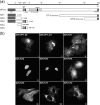Identification of a highly conserved, functional nuclear localization signal within the N-terminal region of herpes simplex virus type 1 VP1-2 tegument protein
- PMID: 18385239
- PMCID: PMC2395207
- DOI: 10.1128/JVI.02497-07
Identification of a highly conserved, functional nuclear localization signal within the N-terminal region of herpes simplex virus type 1 VP1-2 tegument protein
Abstract
VP1-2 is a large structural protein assembled into the tegument compartment of the virion, conserved across the herpesviridae, and essential for virus replication. In herpes simplex virus (HSV) and pseudorabies virus, VP1-2 is tightly associated with the capsid. Studies of its assembly and function remain incomplete, although recent data indicate that in HSV, VP1-2 is recruited onto capsids in the nucleus, with this being required for subsequent recruitment of additional structural proteins. Here we have developed an antibody to characterize VP1-2 localization, observing the protein in both cytoplasmic and nuclear compartments, frequently in clusters in both locations. Within the nucleus, a subpopulation of VP1-2 colocalized with VP26 and VP5, though VP1-2-positive foci devoid of these components were observed. We note a highly conserved basic motif adjacent to the previously identified N-terminal ubiquitin hydrolase domain (DUB). The DUB domain in isolation exhibited no specific localization, but when extended to include the adjacent motif, it efficiently accumulated in the nucleus. Transfer of the isolated motif to a test protein, beta-galactosidase, conferred specific nuclear localization. Substitution of a single amino acid within the motif abolished the nuclear localization function. Deletion of the motif from intact VP1-2 abrogated its nuclear localization. Moreover, in a functional assay examining the ability of VP1-2 to complement growth of a VP1-2-ve mutant, deletion of the nuclear localization signal abolished complementation. The nuclear localization signal may be involved in transport of VP1-2 early in infection or to late assembly sites within the nucleus or, considering the potential existence of VP1-2 cleavage products, in selective localization of subdomains to different compartments.
Figures






Similar articles
-
Functional analysis of nuclear localization signals in VP1-2 homologues from all herpesvirus subfamilies.J Virol. 2014 May;88(10):5391-405. doi: 10.1128/JVI.03797-13. Epub 2014 Feb 26. J Virol. 2014. PMID: 24574406 Free PMC article.
-
A Nuclear localization signal in herpesvirus protein VP1-2 is essential for infection via capsid routing to the nuclear pore.J Virol. 2012 Sep;86(17):8998-9014. doi: 10.1128/JVI.01209-12. Epub 2012 Jun 20. J Virol. 2012. PMID: 22718835 Free PMC article.
-
Characterization of the herpes simplex virus (HSV)-1 tegument protein VP1-2 during infection with the HSV temperature-sensitive mutant tsB7.J Gen Virol. 2009 Oct;90(Pt 10):2353-2363. doi: 10.1099/vir.0.012492-0. Epub 2009 Jul 8. J Gen Virol. 2009. PMID: 19587138
-
Identification of a minimal hydrophobic domain in the herpes simplex virus type 1 scaffolding protein which is required for interaction with the major capsid protein.J Virol. 1996 Jan;70(1):533-40. doi: 10.1128/JVI.70.1.533-540.1996. J Virol. 1996. PMID: 8523566 Free PMC article.
-
Residues of VP26 of herpes simplex virus type 1 that are required for its interaction with capsids.J Virol. 2003 Jan;77(1):391-404. doi: 10.1128/jvi.77.1.391-404.2003. J Virol. 2003. PMID: 12477844 Free PMC article.
Cited by
-
pUL36 Deubiquitinase Activity Augments Both the Initiation and the Progression of Lytic Herpes Simplex Virus Infection in IFN-Primed Cells.J Virol. 2022 Nov 23;96(22):e0096322. doi: 10.1128/jvi.00963-22. Epub 2022 Oct 31. J Virol. 2022. PMID: 36314822 Free PMC article.
-
Intracellular localization of the pseudorabies virus large tegument protein pUL36.J Virol. 2009 Oct;83(19):9641-51. doi: 10.1128/JVI.01045-09. Epub 2009 Jul 29. J Virol. 2009. PMID: 19640985 Free PMC article.
-
Nuclear targeting of human cytomegalovirus large tegument protein pUL48 is essential for viral growth.J Virol. 2013 May;87(10):6005-19. doi: 10.1128/JVI.03558-12. Epub 2013 Mar 20. J Virol. 2013. PMID: 23514890 Free PMC article.
-
The Race between Host Antiviral Innate Immunity and the Immune Evasion Strategies of Herpes Simplex Virus 1.Microbiol Mol Biol Rev. 2020 Sep 30;84(4):e00099-20. doi: 10.1128/MMBR.00099-20. Print 2020 Nov 18. Microbiol Mol Biol Rev. 2020. PMID: 32998978 Free PMC article. Review.
-
Post-translational Control of Innate Immune Signaling Pathways by Herpesviruses.Front Microbiol. 2019 Nov 14;10:2647. doi: 10.3389/fmicb.2019.02647. eCollection 2019. Front Microbiol. 2019. PMID: 31798565 Free PMC article. Review.
References
Publication types
MeSH terms
Substances
LinkOut - more resources
Full Text Sources

